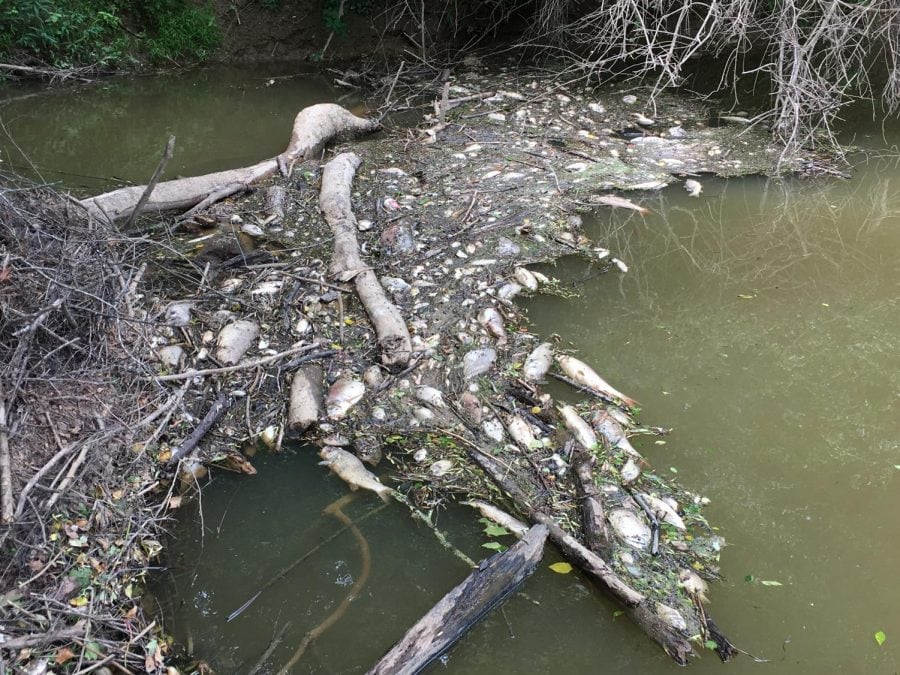Months after a spill contaminated the Black Warrior River, ADEM is still silent
Photo courtesy of Black Warrior Riverkeeper
An estimated 125,000 fish were killed in the Black Warrior River after waste spill at a Tyson Foods plant in Hanceville, Alabama. Photo courtesy of Black Warrior Riverkeeper
October 3, 2019
When Tyson Foods leaked toxic waste into two Black Warrior River tributaries this summer, communities sought answers. But, months later, the state’s environmental agency has yet to issue any penalties against the corporation.
On June 6, Tyson Foods had a waste spill that spread E. coli, killing an estimated 175,000 fish in the Black Warrior River. On June 9, ADEM claimed that the water was safe for recreation again.
The spill took place in Hanceville, which is about 100 miles north of Tuscaloosa and flowed into the Sipsey Fork and Mulberry Fork rivers, which are tributaries of the Black Warrior River.
Many Alabama residents were angered by the spill because it wasn’t Tyson Foods’ first accident. Their first spill was in 2016, which killed 40,000 fish.
After the spill occurred, Black Warrior Riverkeeper Nelson Brooke sampled the river and created a map showing the spills from June 6 to June 13. The Alabama Department of Environmental Management also collected samples on both dates, but the June 6 data was not as accessible as the June 13 data, according to a Sept. 6 report by WBRC News. In contrast to the June 13 data, which was more widely circulated and reported relatively low toxicity levels, the June 6 data was much more glaring.
“On June 6, The Alabama Department of Environmental Management found alarmingly high levels (over 30 times the state level considered safe for swimming/contact) of E. coli bacteria in the Mulberry Fork downstream of the Tyson spill,” Brooke said in a Sept. 9 press release. “ADEM never released those sample results to the public until recently – over 2.5 months later – despite the fact that Black Warrior Riverkeeper, the public, and the media were asking for this very information over the weeks and months that followed the spill.”
The Riverkeeper’s press release was an update to a series of releases about the results of an ADEM investigation following the June spills, in which he published his own samples and urged residents to ask ADEM for more answers regarding the discrepancies between his research and the state agency’s.
“It is unfortunate ADEM did not provide adequate public notification in the days following the Tyson spill to inform the public and ensure people were not exposed to dangerous water,” Brooke said. “It is time for ADEM to admit it is failing to perform its investigative and public notification duties. It is time for ADEM to establish a robust public notification system for spills and other major incidents, and to institute a system of transparency to the public.”
Katie Jack is a second-year UA graduate student getting her master’s in geography and conducting research on environmental justice. Jack described ADEM’s handling of the spill as an “environmental injustice.”
“It feels like a betrayal of my trust,” she said. “You’re told to trust the government, that they’re taking care of you, and they did the exact opposite.”
Jack defined environmental justice as “the belief that everyone deserves a healthy place to live, work and play. Injustice is when that doesn’t happen.”
According to Jack’s research, injustice is much more likely to happen in low-income areas.
In the case of the Tyson waste spill, there are several low-income communities affected such as Walker County, which has a median income about 20% lower than the rest of Alabama, and a poverty level about 16% higher than the rest of Alabama.
“To supplement their food, there are actually quite a few low-income communities which fish in the Black Warrior River,” Jack said. “To me, that’s super concerning.”
As residents have urged ADEM to issue a costly penalty to Tyson, the agency’s director Lance LeFleur stressed the need for industry compliance.
“We often get criticized by different folks that we are not aggressive enough in our penalty assessments to the violating entities,” LeFleur told AL.com. “I don’t like to use the dollar amount of penalties as a measure of performance.”
Jack questioned LeFleur’s philosophy, arguing that a prolonged investigation without direct action may be at the expense of residents.
“ADEM prevented people from having the information necessary to take precautions,” Jack said.
“People may have placed themselves in danger without knowing it, and that’s not fair.”
Jack may be upset by ADEM’s inaction, but she is not surprised.
“Nothing really surprises me anymore because of all the things I’ve read about which have happened in Alabama and which have been covered up,” Jack said. “Alabama has always resisted environmental regulations. I wish there was more accountability.”
Jack explained a concept called “tragedy of the commons,” which describes a common resource that is exploited until it’s completely degraded.
“The Black Warrior River has become that,” she said. “It is a common resource, something that we all use, but there are so many corporations along it that have abused it so much that is has become degraded. No one I know wants to get in the Black Warrior River, even before the spill. It’s not clean, and it shouldn’t be that way. We should be able to use natural resources, all of us, but certain large corporations have made it impossible to enjoy what is a common resource.”
As of today, ADEM has still not announced its enforcement decision for the fish kill. Nelson urged concerned citizens to contact the following officials:
- Water Division Chief, Jeff Kitchens (jwk@adem.state.al.us)
- EPA’s Region 4 office in Atlanta, which oversees ADEM:
- Water Protection (404) 562-9345
- or Natalie Ellington (404) 562-9453 | Ellington.Natalie@epa.gov
- To write elected officials with concerns about Tyson’s spill and ADEM’s investigation: https://www.usa.gov/elected-officials








